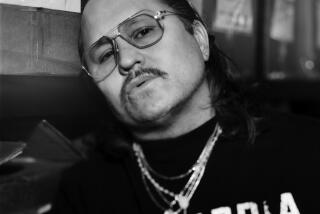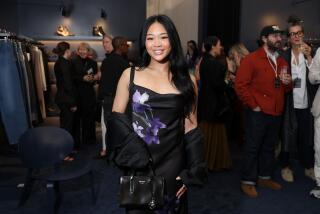Satire That Never Goes Out of Style
It’s hard to be funnier than fashion, something that’s innately ridiculous. The punch lines are everywhere--beautiful people with ugly tattoos or pre-dirtied denims that cost 400 times the original from a rag pile. No monologuist can resist making the new super low-cut jeans the butt of a joke, not when they turn a plumber’s trademark into a fashion statement.
Fashion is as laughable as it is lamentable, which makes it a tricky subject for a comedy. Perhaps that’s why in the new movie “Zoolander,” Ben Stiller, the writer, director and star, missed a chance to make the ultimate fashion satire that the industry’s superficiality so deserves.
“Zoolander” is, however, a wildly funny spoof of the male modeling world that’s funnier if you get the many fashion in-jokes. Playing dimwitted fashion model Derek Zoolander, Stiller is unwittingly caught up in a complex international assassination scheme.
As an artistic enterprise whose convoluted inner workings sometimes defy the label “industry,” the making, marketing and, especially, modeling, of clothing are a humor target begging for a movie maker’s bull’s-eye. So many arrows have missed. Director Robert Altman’s cynical 1994 film “Ready to Wear” (a.k.a., “Pret-a-Porter”) tried to pierce the heart of the international fashion show circuit, only to fall on his own weapon. Then in 1995, filmmaker Douglas Keeve turned washed-up fashion designer and aspiring stand-up comic Isaac Mizrahi into a documentary subject for “Unzipped.” The laughs derived more from the designer’s quirky neuroses, and less from any witty indictment of fashion at large. Now Stiller, a seasoned fashion insider, takes aim, and with a gentle lob, hits that sweet spot squarely, though softly.
In his hands, even the serious issues of bulimia, drug use and homelessness get a comic treatment, not the outrage that they more often inspire. An angrier mind might have added other recent fashion trends of the same ilk--heroin chic and child pornography--to the joke file. Either those taboos fell to the cutting room floor or they’re on Stiller’s list of sequel topics.
Stiller’s deep involvement on screen and off provides a command that keeps the movie, perhaps purposely, wobbling along the edge of truth and fiction. You can’t make up some of the stuff that makes fashion so insane and insanely funny. And that’s where Stiller knew to leave well enough alone.
It’s not, after all, such a farfetched notion that the slightly bowlegged Stiller and the broken-nosed co-star Owen Wilson could be models. Every season, the latest crop of models wrenches the notion of male attractiveness. One year they’re wretched and gangly, the next, scary Aryan soldier-types, and the next, pitiful eunuchs. It’s not such a stretch to imagine Will Ferrell as eccentric designer Mugatu, a composite of designer neuroses and props. Mugatu downplays his humble fashion origins as the inventor of the piano-keyboard-printed tie. Like him, fashion billionaire Ralph Lauren started as a struggling tie designer before his jump to international acclaim. Such behind-the-scenes punch lines give the movie enough fuel for fashion cynics to burn.
I may have been the only one cackling when Zoolander emerges from his apartment, an Ikea-furnished dump above the SoHo Helmut Lang store. That scene isn’t funny unless you’ve seen how fashion hates to leave its ghetto. Geographically and psychologically, the primary proponents exist in an enclave where self-absorption and status obsession form the boundaries. That’s why seemingly everyone circulates within delivery distance of upscale boutiques and nightspots. Designer labels are important to this crowd because the clothes do the automatic sorting of who gets inside its gilded confines.
Even the film’s casting worked an inside-out joke. Comedian Garry Shandling was an odd choice for a celebrity hanger-on until I noticed his resemblance to famous fashion photographer Mario Testino. What? Was Testino too busy to star as himself, or was it just funnier to force the in-group to do a double take? David Bowie pops in seemingly from nowhere until you recall his fashion ancestry: He’s married to model Iman. The blurry line that separates models from actors becomes a plot punch line and a casting directive. Playing herself, 1990s supermodel Claudia Schiffer has evolved into a pop culture cartoon, while model-actress Milla Jovovich as the evil Katinka becomes the personification of fashion snobbery. The ever-ubiquitous, spotlight-loving designers Tommy Hilfiger and Tom Ford gleefully play themselves.
For the ordinary viewer, Stiller dressed up his story with some of fashion’s big-zinger, can’t-miss-’em jokes to make the plot “fresh,” as we say in fashionese. Brainless models, preposterous wardrobes and a troupe of narcissists who slavishly follow every half-witted trend are as obvious and necessary to Stiller’s tale as jutting cheekbones are to Veronica Webb. Who is Veronica Webb, you ask? Just a supermodel you’ve seen so many times, she’s recognizable in a 100th-of-a-second shot of her sitting in a show front row. That alone is commentary enough on our fashion-saturated culture.
There are many such moments that edge the film beyond a silly spoof. Screenplay authors Stiller, Drake Sather and John Hamburg skewer everything from fashionistas’ infatuation with cell phone gadgetry to the implicit vulgarity of the body business and the suspicion that Vogue editor Anna Wintour and designer Karl Lagerfeld--who are slyly caricatured--are a secret, evil cartel.
But it’s certainly no secret to anyone who has ever had a chance to peek behind the fashion machine and see its inner workings. Stiller himself was first granted the privilege back in a sweltering summer of 1996. The actor then seemed an improbable choice to make the rounds of the men’s New York fashion shows at the behest of Hugo Boss, a German fashion company desperate for some rub off of Hollywood glitter. In exchange for bringing his parents (and future Zoolander co-stars) Jerry Stiller and Anne Meara, and new pal Wilson to a swank dinner with fashion editors and Boss honchos, the clothier outfitted the rising Hollywood stars with Hugo Boss clothes. That experience helped Stiller along with writer Sather create the Derek Zoolander character who debuted some months later in a VH1/Vogue Fashion Awards skit.
Now Stiller, with a cover story in GQ and an elaborate fashion editorial in the October Vogue, is a certified insider, a status that can bestow privileged show seating, discounts and party invitations.
And as anyone in fashion knows, you’re either on the list, or off the list. If Stiller had cut deeper into the fashion fabric, he’d risk not just banishment, but a worse fate. He might--gasp!--be declared out of style. Yesterday’s news.
More to Read
Only good movies
Get the Indie Focus newsletter, Mark Olsen's weekly guide to the world of cinema.
You may occasionally receive promotional content from the Los Angeles Times.










